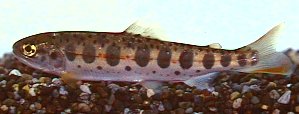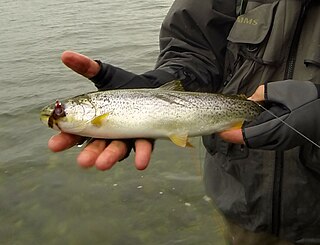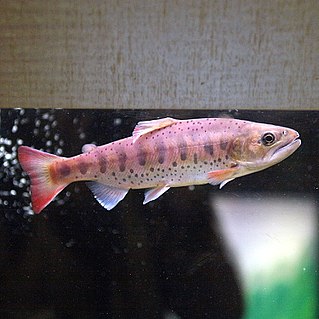
Trout are species of freshwater fish belonging to the genera Oncorhynchus, Salmo and Salvelinus, all of the subfamily Salmoninae of the family Salmonidae. The word trout is also used as part of the name of some non-salmonid fish such as Cynoscion nebulosus, the spotted seatrout or speckled trout.

Salmonidae is a family of ray-finned fish, the only living family currently placed in the order Salmoniformes. It includes salmon, trout, chars, freshwater whitefishes, and graylings, which collectively are known as the salmonids. The Atlantic salmon and trout of the genus Salmo gives the family and order their names.

Many types of fish migrate on a regular basis, on time scales ranging from daily to annually or longer, and over distances ranging from a few metres to thousands of kilometres. Fish usually migrate to feed or to reproduce, but in other cases the reasons are unclear.

Oncorhynchus masou, known as the masu salmon, masu, or the cherry hybrid salmon, is a species of salmon found in the northern part of the Pacific Ocean along East Asia, ranging from the Kamchatka, Kuril Islands, Sakhalin, and Primorsky Krai south through Korea, Taiwan, and Japan. A number of subspecies are known, including the anadromous, widespread masu Oncorhynchus masou masou, the critically endangered, landlocked Taiwanese or Formosan salmon Oncorhynchus masou formosanus found in certain freshwater systems of Taiwan, the Biwa trout endemic of Lake Biwa, and the anadromous or stream-dwelling amago Oncorhynchus masou macrostomus restricted to western Japan.

The rainbow trout is a trout and species of salmonid native to cold-water tributaries of the Pacific Ocean in Asia and North America. The steelhead is an anadromous (sea-run) form of the coastal rainbow trout(O. m. irideus) or Columbia River redband trout (O. m. gairdneri) that usually returns to fresh water to spawn after living two to three years in the ocean. Freshwater forms that have been introduced into the Great Lakes and migrate into tributaries to spawn are also called steelhead.

Steelhead Trout is a name given to the anadromous form of the coastal rainbow trout (Oncorhynchus. m. irideus) or redband trout (O. m. gairdneri). The steelhead are native to freshwater and ocean environments across North America, but have been introduced to every other continent except Antarctica. Steelhead use aquatic obstructions like vegetation, boulders, and fallen trees as protection. Steelhead migrate to spawn during the summer months and the winter months.

The Golden Trout, also known as the Californiangolden trout (Oncorhynchus aguabonita or Oncorhynchus mykiss aguabonita), is a species of trout native to California. The golden trout is normally found in the Golden Trout Creek, Volcano Creek, and the South Fork Kern River. It is the state freshwater fish of California.

Sea trout is the common name usually applied to anadromous forms of brown trout, and is often referred to as Salmo trutta morpha trutta. Other names for anadromous brown trout are sewin (Wales), peel or peal, mort, finnock (Scotland), white trout (Ireland) and salmon trout (culinary). The term sea trout is also used to describe other anadromous salmonids—coho salmon, brook trout, Arctic char, cutthroat trout and Dolly Varden. Even some non-salmonid species are also commonly known as sea trout—Northern pikeminnow and members of the weakfish family (Cynoscion).

Oncorhynchus is a genus of fish in the family Salmonidae; it contains the Pacific salmon and Pacific trout. The name of the genus is derived from the Greek ὄγκος + ῥύγχος, in reference to the hooked jaws of males in the mating season.

The Columbia River redband trout, the inland redband trout or the interior redband trout is one of three redband trout subspecies of the rainbow trout in the family Salmonidae. It is native in the Columbia River and its tributaries in Montana, Oregon, Washington and Idaho. It includes sea-run anadromous forms, which are known as redband steelhead. Also the large Kamloops rainbow trout is included.

Freshwater fish are those that spend some or all of their lives in fresh water, such as rivers and lakes, with a salinity of less than 1.05%. These environments differ from marine conditions in many ways, the most obvious being the difference in levels of salinity. To survive fresh water, the fish need a range of physiological adaptations.

The westslope cutthroat trout, also known as the black-spotted trout, common cutthroat trout and red-throated trout is a subspecies of the cutthroat trout and is a freshwater fish in the salmon family of order Salmoniformes. The cutthroat is the Montana state fish. This subspecies is a species of concern in its Montana and British Columbia ranges and is considered threatened in its native range in Alberta.

San Leandro Creek is a 21.7-mile-long (34.9 km) year-round natural stream in the hills above Oakland in Alameda County and Contra Costa County of the East Bay in northern California.

The coastal cutthroat trout, also known as the sea-run cutthroat trout, blue-back trout or harvest trout, is one of the several subspecies of cutthroat trout found in Western North America. The coastal cutthroat trout occurs in four distinct forms. A semi-anadromous or sea-run form is the most well known. Freshwater forms occur in both large and small rivers and streams and lake environments. The native range of the coastal cutthroat trout extends south from the southern coastline of the Kenai Peninsula in Alaska to the Eel River in Northern California. Coastal cutthroat trout are resident in tributary streams and rivers of the Pacific basin and are rarely found more than 100 miles (160 km) from the ocean.

The amago or the red-spotted masu salmon is a salmonid fish endemic to western Japan, and a subspecies of the more widespread Northwest Pacific masu salmon or cherry salmon. It is distinguished by the presence of red or vermilion spots on the body along with black ones, while the nominate form O. masou masou, known as the yamame, only has black ones. The amago is distributed in western Japan, on the Pacific side of the Honshu and Shikoku islands, and on the Inland Sea of Japan side of Kyushu. The subspecies is a subject of aquaculture. It can grow up to 50 cm (20 in) length.
The Baja California rainbow trout or San Pedro Martir trout or Nelson's trout is a localized subspecies of the rainbow trout, a freshwater fish in the family Salmonidae.

The Little Kern golden trout is a brightly colored subspecies of rainbow trout native to the main stem and tributaries of the Little Kern River in Tulare County, California. Together with the California golden trout and the Kern River rainbow trout, the Little Kern golden trout forms what is sometimes referred to as the "golden trout complex" of the Kern River basin.















